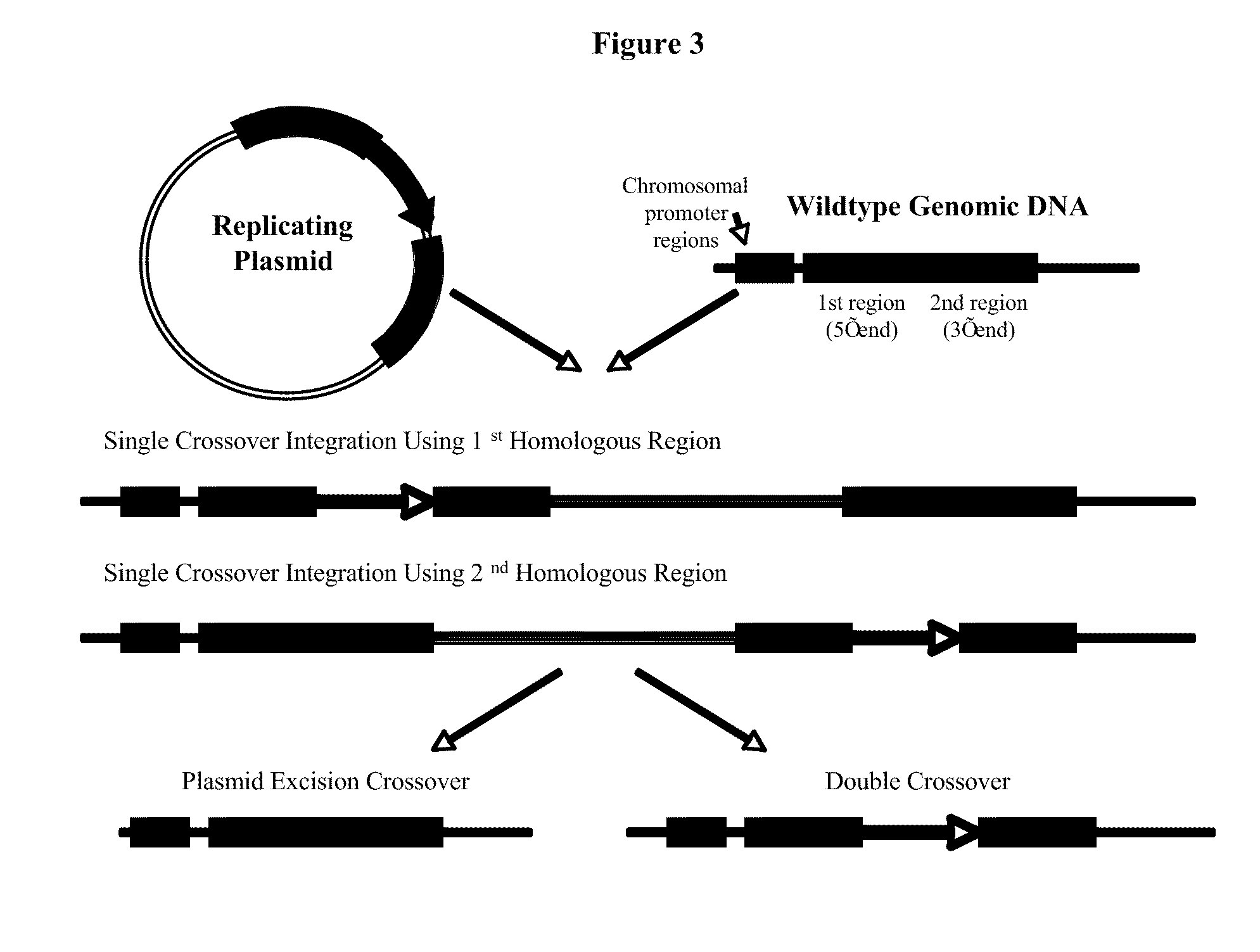Methods and compositions for generating sporulation deficient bacteria
a technology of sporulation and bacteria, applied in the field of methods and compositions for engineering sporulation deficient bacteria, can solve the problems of slow adoption of these technologies, low productivity of batch bioreactors, and high cost, and achieve the effects of reducing the expression of sporulation genes, increasing solvent, and increasing solven
- Summary
- Abstract
- Description
- Claims
- Application Information
AI Technical Summary
Benefits of technology
Problems solved by technology
Method used
Image
Examples
example 1
Transcriptional Profiling
[0068]To capture the transcriptional, physiological, and morphological changes (Alsaker and Papoutsakis, Journal of Bacteriology, 2005. 187(20): p. 7103-7118; Jones et al., Applied and Environmental Microbiology, 1982. 43(6): p. 1434-1439) occurring during the C. acetobutylicum sporulation process, RNA samples were taken every hour during exponential phase and every two hours after, until late stationary phase. A total of 25 timepoints were selected for transcriptional analysis by hybridizing pairs of 22 k oligonucleotide microarrays on a dye swap configuration using an mRNA pool as reference.
[0069]Bacilli sporulation is controlled by the conserved, master transcriptional regulator, Spo0A (Paredes et al., supra). spo0A expression peaked at hour 12 and maintained a minimum of 3-fold induction, relative to the first timepoint, until hour 36 (FIG. 1). Once phosphorylated in C. acetobutylicum, Spo0A regulates the expression of the operons encoding sigF, sigE, an...
example 2
sigE Knockout in WT Background
Construction of sigE Targeted Gene Disruption Plasmid
[0071]For the C. acetobutylicum sigE gene (CAC 1695) targeted plasmid, the disrupted sigE gene fragment was constructed in the pCR8-GW-TOPOTA™ cloning plasmid from Invitrogen. A 559 bp region of the sigE gene was PCR amplified with Taq polymerase and SigE-F / R primer set, and then cloned into the pCR8-GW-TOPOTA™ cloning plasmid and One Shot® TOP10 E. coli via manufacturer suggestions. The resulting plasmid is called pCR8-SigE. The sigE gene fragment was then disrupted in approximately the middle of the gene fragment via a NdeI endonuclease digestion. The linear plasmid was blunt ended via NEBR Klenow (large fragment) treatment and then dephosphorylated. An antibiotic cassette was cloned into the linear plasmid via NEB Quick Ligase and cloned into Invitrogen® One Shot® TOP10 E. coli. The antibiotic cassette for the sigE disruption was a modified chloramphenicol / thiamphenicol (CM / TH) marker described lat...
example 3
sigG Targeted asRNA
[0083]Construction of sigG (CAC1696) Targeted asRNA (pAS-CAC1696)
[0084]DNA oligos were designed to target sigG based upon a method previously described (Desai and Papoutsakis, Applied and Environmental Microbiology, 1999. 65(3): p. 936-945). The oligos included 20 base pairs upstream of the start codon (includes the ribosomal binding), the first 13 codons of sigG, a gInA asRNA terminator and 5′-overhangs for directed cloning into a BamHI / KasI double digestion. The oligo sequences are given in the primer and asRNA oligo sequences table and are referred to as CAC1696-asRNA-S and CAC 1696-asRNA-AS. The oligos were annealed and ligated into the double digested pSOS95del, and screened for ampicillin resistance in Invitrogen TOP10 E. coli. The resulting asRNA targets the ribosomal binding region and the first 13 codons of the sigG mRNA. It is expressed from the C. acetobutylicum thL promoter, which is a strong promoter.
Morphology Results from sigG Targeted asRNA
[0085]Si...
PUM
| Property | Measurement | Unit |
|---|---|---|
| concentrations | aaaaa | aaaaa |
| concentrations | aaaaa | aaaaa |
| concentrations | aaaaa | aaaaa |
Abstract
Description
Claims
Application Information
 Login to View More
Login to View More - R&D
- Intellectual Property
- Life Sciences
- Materials
- Tech Scout
- Unparalleled Data Quality
- Higher Quality Content
- 60% Fewer Hallucinations
Browse by: Latest US Patents, China's latest patents, Technical Efficacy Thesaurus, Application Domain, Technology Topic, Popular Technical Reports.
© 2025 PatSnap. All rights reserved.Legal|Privacy policy|Modern Slavery Act Transparency Statement|Sitemap|About US| Contact US: help@patsnap.com



